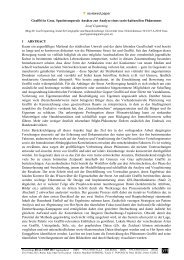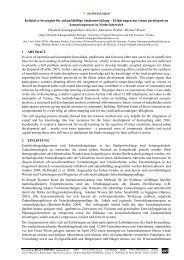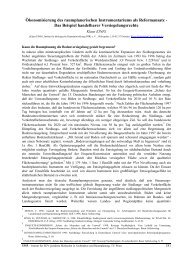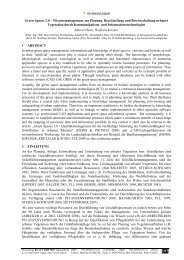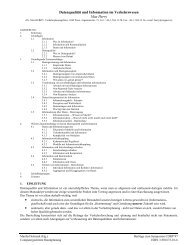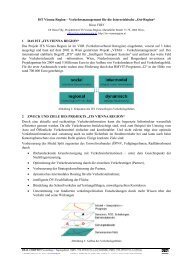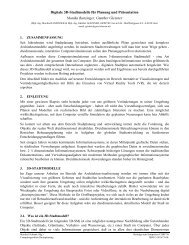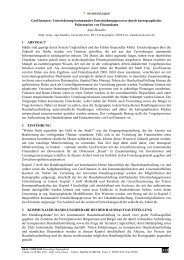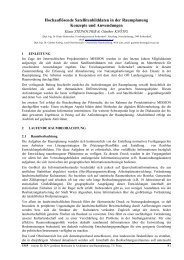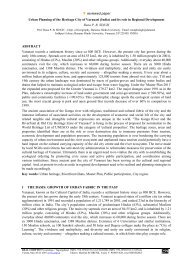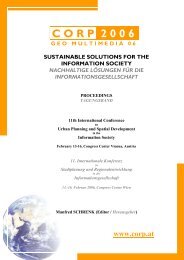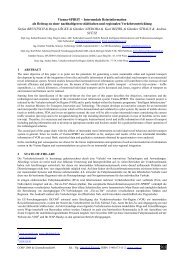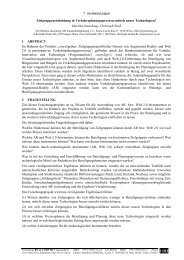Sustainable Urbanism with Green Roofs – Natural ... - CORP
Sustainable Urbanism with Green Roofs – Natural ... - CORP
Sustainable Urbanism with Green Roofs – Natural ... - CORP
Create successful ePaper yourself
Turn your PDF publications into a flip-book with our unique Google optimized e-Paper software.
<strong>Sustainable</strong> <strong>Urbanism</strong> <strong>with</strong> <strong>Green</strong> <strong>Roofs</strong> <strong>–</strong> <strong>Natural</strong> Stormwater Management<br />
Wolfgang Ansel, Alfred Diem<br />
(Dipl. Wirt.-Biol. Wolfgang Ansel, International <strong>Green</strong> Roof Association (IGRA), PO Box 2025, 72610 Nürtingen, Germany,<br />
ansel@igra-world.com)<br />
(Dipl. Ing.(FH) Alfred Diem, diem.baker GbR, Ingenieure für Bautechnik, Ditzenbrunner Str. 4, 71254 Ditzingen, Germany,<br />
a.diem@diembaker.de)<br />
1 ABSTRACT<br />
In the district Zazenhausen, the City of Stuttgart (Germany) is developing the new building site,<br />
‘Hohlgrabenäcker’. In total, the final construction on an area of 16.7 ha shall comprise approx. 265 private<br />
homes and 9 apartment buildings in relatively dense development. Through the combination of cisterns,<br />
infiltration pavement and green roofs, significant costs could be diverted from rainwater management.<br />
Concurrently, the green roofs provide the important contribution of reducing the impact of the building<br />
measures on ecosystem functions.<br />
2 INTRODUCTION<br />
In recent years flood disasters have become ‘an inconvenient truth’ for many people. On a local scale this<br />
problem is very often man-made due to the paving over of open land. As a result, the natural water cycle is<br />
defective and most of the precipitation during a rainstorm is immediately routed into overloaded storm-sewer<br />
pipes. Moreover, the impacts of global warming and the attendant stronger storms <strong>with</strong> more rainfall have<br />
intensified the situation. This means that at present, public water authorities are at a crossroads. They can try<br />
to solve the problem conventionally by costly end-of-pipe interventions, e.g. the extension of stormwater<br />
collection, storage and treatment facilities. However, these efforts fail to address the source of the problem <strong>–</strong><br />
impervious surfaces. Therefore, modern stormwater management policies go upstream and manage the<br />
problem in a sustainable way by using green roofs for temporary water storage.<br />
Within the array of preventive stormwater management techniques green roofs play an outstanding part. This<br />
is not only due to the fact that 40-50 % of sealed surfaces in urban agglomerations represent roofs.<br />
Moreover, green roofs are real all-rounders in both an economical and ecological sense. Depending on the<br />
green roof system build-up and substrate, the immediate water runoff from vegetated roofs can be reduced by<br />
50-90% (ROTH-KLEYER 2009). A large part of the water returns into the natural water cycle by<br />
transpiration of the plants and evaporation from the substrate. The accompanying cooling effect of this<br />
process contributes to a better microclimate and a decrease of the ‘urban heat island effect’.<br />
The remaining excess rainwater drains from green roofs <strong>with</strong> a substantial lag time so the peak flow rates are<br />
reduced. Due to the natural drainage pattern of green roofs less or smaller dimensioned sewerage systems<br />
can be installed on new development areas or large projects. Innovative stormwater master-plans include the<br />
combination of green roofs <strong>with</strong> cisterns, so the roof water not absorbed by the green roof build-up will be<br />
captured and provide grey water for other uses (e.g. irrigation, flushing toilets). As stormwater volume<br />
reduction benefits the budgets of the municipalities, many water authorities promote the opening of scaled<br />
surfaces <strong>with</strong> financial incentives. In Germany, for example, property owners receive a special discount on<br />
the annual stormwater taxes for areas which are covered by green roofs (ANSEL 2009).<br />
3 CASE STUDY STUTTGART-ZAZENHAUSEN<br />
The first indication of integrating green roofs into the development of the building site “Hohlgrabenäcker” in<br />
Stuttgart-Zazenhausen already appears in the land development plan of the City of Stuttgart. Effective since<br />
2000, the land development plan 2010 is the pivotal controlling tool that directs urban planning and<br />
development of Baden-Württemberg’s capital city on a sustainable course. In order to minimize<br />
encroachment and provide internal compensation measures in the building site ‘Hohlgrabenäcker’,<br />
ecological stipulations were proposed in the land development plan for the comprehensive building site,<br />
notably green roofs and stormwater retention and -infiltration.<br />
Given that the development of the housing area assumes significantly detrimental impacts on the<br />
environment, an Environmental Impact Assessment (EIA) was conducted before the development plan was<br />
assembled. In doing so, the Environmental Impact Assessment considers the effects of a construction project<br />
on the protection of humans, animals, plants, soil, water, air, climate, landscape, as well as culture and other<br />
REAL <strong>CORP</strong> 2010 Proceedings/Tagungsband<br />
Vienna, 18-20 May 2010 <strong>–</strong> http://www.corp.at<br />
Editors: Manfred SCHRENK, Vasily V. POPOVICH, Peter ZEILE<br />
1291
<strong>Sustainable</strong> <strong>Urbanism</strong> <strong>with</strong> <strong>Green</strong> <strong>Roofs</strong> <strong>–</strong> <strong>Natural</strong> Stormwater Management<br />
real assets. The measures that were recommended on the basis of the assessment - for prevention,<br />
minimization and compensation - are then found again as regulations in the development plan. While the<br />
regulation of green roofs as minimization measure for the protection of species, biotopes, water, climate and<br />
natural scenery has become standard in the interim, the active integration of green roofs <strong>with</strong> drainage<br />
planning is still rather something of a special case.<br />
To this end, layer depth of the green roof substrate plays a decisive role for green roof function as primary<br />
stormwater storage and for delayed runoff occurring from long-lasting rain events. For the regulation of<br />
extensive green roofs in the development plan, therefore, from the framework of an integrated approach, a<br />
higher value for substrate depth was deliberately selected (12 cm), such that the runoff coefficient from the<br />
roof surfaces would achieve the desired value of 0.3.<br />
The regulations for extensive green roofs in the development plan are as follows:<br />
“Free-standing garages and carports must be greened. Here the green roof must have a substrate depth of at<br />
least 12 cm. The substrate layer is to be planted <strong>with</strong> grasses and wild herbs and shall be preserved as such<br />
(extensive green roof).”<br />
„For retention of stormwater, areas <strong>with</strong> flat and single-pitch roofs are to be covered <strong>with</strong> green roofs. …<br />
Here the green roof must have a substrate depth of at least 12 cm. The substrate layer is to be planted <strong>with</strong><br />
grasses and wild herbs and shall be preserved as such.”<br />
The total green roof area of the building site ‘Hohlgrabenäcker’ adds up to a total of 18,300 m². Regulating<br />
green roofs into the development plan was there<strong>with</strong> an important step for achieving the ambitiously low<br />
degree of 20 % imperviousness <strong>with</strong>in the building site.<br />
4 SPECIFICATIONS AND BASIC CONDITIONS FOR THE DRAINAGE DESIGN<br />
4.1 Legal basis<br />
According to the Water Act for Baden-Württemberg (WG) § 45 b Abs. 3, when technically possible and<br />
<strong>with</strong>out incurring damage, stormwater from new development sites should infiltrate or be conveyed away<br />
separately. It is important to note here that selective runoff infiltration in Baden-Württemberg may only be<br />
accomplished in troughs <strong>with</strong> over-grown topsoil layers.<br />
4.2 Municipal specifications<br />
Because of limited capacity of existing sewers, the planned new development site ‘Hohlgrabenäcker’ is<br />
required by statement of Stuttgart City Council to comply <strong>with</strong> a maximum runoff co-efficient of 0.3<br />
(impervious degree of 30 %).<br />
4.3 Hydro-geological conditions<br />
The soil analyses that were conducted indicate predominantly homogenous, cohesive soils in the upper layer,<br />
which is the layer that is relevant for precipitation abatement. These soil types have limited suitability for<br />
stormwater infiltration. Prospecting did not reveal noteworthy levels of groundwater. Furthermore, the steep<br />
hillside situation (in parts over 10 %) strongly restricts the possibilities for surficial stormwater infiltration.<br />
5 THE DRAINAGE CONCEPT IN PRACTICE<br />
Due to the specifications and basic conditions described above, drainage by separate sewer system is<br />
obligatory. Residential wastewater is collected via drainage system and passed into an existing combined<br />
wastewater sewer. The basic conditions encountered at the building site did not permit comprehensive and<br />
selective stormwater infiltration, so a combination from various basic elements of stormwater management<br />
came into use.<br />
5.1 Drainage from private areas:<br />
Facilities for rainwater storage and -use on all built surfaces upon which single- or semi-detached housing<br />
(loose development) are planned and for which no obligation for green roof construction exist. Rainwater<br />
storage results from cistern facilities on private properties which empty partially by force. The part of the<br />
cistern volume that is not partially emptying can be used by the property owners for rainwater use. In<br />
1292<br />
REAL <strong>CORP</strong> 2010:<br />
CITIES FOR EVERYONE. Liveable, Healthy, Prosperous
REAL <strong>CORP</strong> 2010 Proceedings/Tagungsband<br />
Vienna, 18-20 May 2010 <strong>–</strong> http://www.corp.at<br />
Editors: Manfred SCHRENK, Vasily V. POPOVICH, Peter ZEILE<br />
Wolfgang Ansel, Alfred Diem<br />
accordance <strong>with</strong> DIN 1989, rainwater can be used in house and garden for toilet flushing, washing clothes<br />
and irrigation. In addition to the residential water management benefits of retaining and damping runoff<br />
peaks, the cistern solution offers additional ecological benefits:<br />
• a) Conserve drinking water<br />
• b) Cost reduction for sewers and wastewater treatment.<br />
• c) Reduction of the pollution load discharge to the discharge system.<br />
The drain outlet from the cistern throttle can be connected to the new stormwater sewers in the development<br />
roads.<br />
Figure 1: Cistern installation<br />
In the more densely built area, green roofs are specified for runoff minimisation. Other paved areas must be<br />
furnished <strong>with</strong> permeable coverings. Drains from these properties must also be connected to the stormwater<br />
sewers in the development roads.<br />
Fig. 2: Single-pitch roofs <strong>with</strong> vegetation layer<br />
1293
<strong>Sustainable</strong> <strong>Urbanism</strong> <strong>with</strong> <strong>Green</strong> <strong>Roofs</strong> <strong>–</strong> <strong>Natural</strong> Stormwater Management<br />
5.2 Drainage of public/ open areas:<br />
In terms of transportation, public streets and development areas are restricted to a minimum to reduce the<br />
impervious degree as much as possible. Streets and path surfaces are connected to the new stormwater<br />
sewers. The stormwater sewer discharges directly into the receiving water course (Feuerbach).<br />
Through the consistent use of pervious-friendly material for all of the paths, storage- and living spaces, as<br />
well as the use of green roofs and cistern facilities, an impervious degree of just ca. 20% could be achieved<br />
in the residential area.<br />
Parameters for the development:<br />
1294<br />
• Catchment area stormwater sewers: 15.3 ha<br />
• Paved area: 3.2 ha<br />
• Pervious paving of streets and paths: 16,000 m²<br />
• Total green roof surfaces: 18,300 m²<br />
• Cistern facilties for single-family homes: 47<br />
• Cistern facilties for multi-family homes: 09<br />
6 ECONOMIC COMPARISON<br />
Fig. 3: Infiltration pavement - buildup<br />
By economic comparison, the stormwater design described above can hold out against conventional<br />
stormwater management as well. By conventional construction, the imperviousness of the new development<br />
area would swell to over 40%, and centralized stormwater retention would necessarily require 1,400 m³<br />
useable volume. In open cut construction, an area of at least 1,200 m² would be required. The acquisition of<br />
the land area alone, which comprises around 4 lots, can finance the construction of the decentralized cistern<br />
facilities, as well as the additional costs from the pervious paving and green roofs.<br />
Furthermore, the operational costs of centralized stormwater retention, as well as dropped stormwater fees<br />
for the split wasterwater levy, speak clearly to the conceptual design of the stormwater management selected<br />
for the new development area.<br />
Comparison investment costs:<br />
Conventional stormwater conveyance <strong>with</strong> separate sewer system<br />
REAL <strong>CORP</strong> 2010:<br />
CITIES FOR EVERYONE. Liveable, Healthy, Prosperous
REAL <strong>CORP</strong> 2010 Proceedings/Tagungsband<br />
Vienna, 18-20 May 2010 <strong>–</strong> http://www.corp.at<br />
Editors: Manfred SCHRENK, Vasily V. POPOVICH, Peter ZEILE<br />
Wolfgang Ansel, Alfred Diem<br />
Land acquistion for centralized stormwater retention: 1,200 m² x 600 € 720,000 €<br />
Investment costs for stormwater retention: 1,400 m³ x 120 € 168,000 €<br />
Additional costs estimated for cross-section enlargement of conduits: 50,000 €<br />
Total costs conventional stormwater discharge: 938,000 €<br />
Decentralized stormwater management in new development area<br />
Cistern facilities in single-family homes: 47 x 1,200 € 56,400 €<br />
Cistern facilities in multi-family homes: 9 x 5,000 € 45,000 €<br />
Additional costs for pervious paving instead of asphalt: 17,000 m² x 20 € 340,000 €<br />
Additional costs for green roof:<br />
(Substrate depth 12 cm instead of 8 cm)<br />
18,300 m² x 05 € 91,500 €<br />
Total costs decentralized stormwater management: 532,900 €<br />
Cost savings investment costs:<br />
Decentralized stormwater management vs Conventional stormwater conveyance: 405,100 €<br />
Even when the complete installation costs for the extensive green roofs of ca. 20 Euro / m² are included in<br />
the cost comparison, decentralized stormwater management is still over 100,000 Euro more economical than<br />
conventional discharge. And this says nothing of the annual ecological yield from conserved stormwater fees<br />
which were introduced to Stuttgart in 2007. The basis for this stormwater fee is the built and impervious land<br />
area from which stormwater is discharged into the public sewer system. Measures which serve for natural<br />
stormwater management and which reduce discharge into the sewers are rewarded <strong>with</strong> significant annual<br />
fee reductions.<br />
Decentralized stormwater management: Annual savings in stormwater fee<br />
Cistern facilities 8,240 €<br />
Pervious paving 8,400 €<br />
<strong>Green</strong> roof: 9,040 €<br />
Total savings from decentralized stormwater management:<br />
25,680 €<br />
Savings in stormwater fee over 30 years: 770,400 €<br />
Already in 1998, a cost study by the Ministry of Building and Housing in the German state of North Rhine-<br />
Westfalia came to the conclusion that green roofs are always more cost effective than gravel roofs, when<br />
reduced rates for water retention by green roofs are recognized <strong>with</strong>in the framework of a municipal bylaw.<br />
7 CONCLUSION<br />
With its approach, the building site ‘Hohlgrabenäcker’ could assume a pioneering task in the matter of<br />
ecological stormwater management for new building sites in Stuttgart. In doing so, the full effectiveness of<br />
green roofs arises through integrated planning. Minor modifications to substrate depth can suffice for cost<br />
savings on the order of five-figures (Euro). That green roofs also provide cost savings on heating and air<br />
conditioning through their insluative and shading effects, that they improve the urban climate, and that they<br />
provide new habitats for plants and animals are further important aspects which, in this case, are bonus.<br />
8 IGRA <strong>–</strong> THE INTERNATIONAL GREEN ROOF ASSOCIATION<br />
The International <strong>Green</strong> Roof Association (IGRA) is a global network for the promotion and dissemination<br />
of information on green roof topics and green roof technology. IGRA´s services include networking,<br />
workshops, conferences and all kinds of public relation work. Please find more information at www.igraworld.com.<br />
1295
<strong>Sustainable</strong> <strong>Urbanism</strong> <strong>with</strong> <strong>Green</strong> <strong>Roofs</strong> <strong>–</strong> <strong>Natural</strong> Stormwater Management<br />
9 REFERENCES<br />
Ansel, W.: <strong>Green</strong> roof incentives in Germany <strong>–</strong> proven pocedures and current trends. In: Appl R. Meier R. & Ansel W.: <strong>Green</strong> <strong>Roofs</strong><br />
- Bringing Nature Back to Town, International <strong>Green</strong> Roof Association IGRA, pp 123-126, Berlin 2009<br />
Roth-Kleyer, S: <strong>Green</strong> roofs as a module of urban water management. In: Appl R. Meier R. & Ansel W.: <strong>Green</strong> <strong>Roofs</strong> - Bringing<br />
Nature Back to Town, International <strong>Green</strong> Roof Association IGRA, pp 63-71, Berlin 2009<br />
1296<br />
REAL <strong>CORP</strong> 2010:<br />
CITIES FOR EVERYONE. Liveable, Healthy, Prosperous



